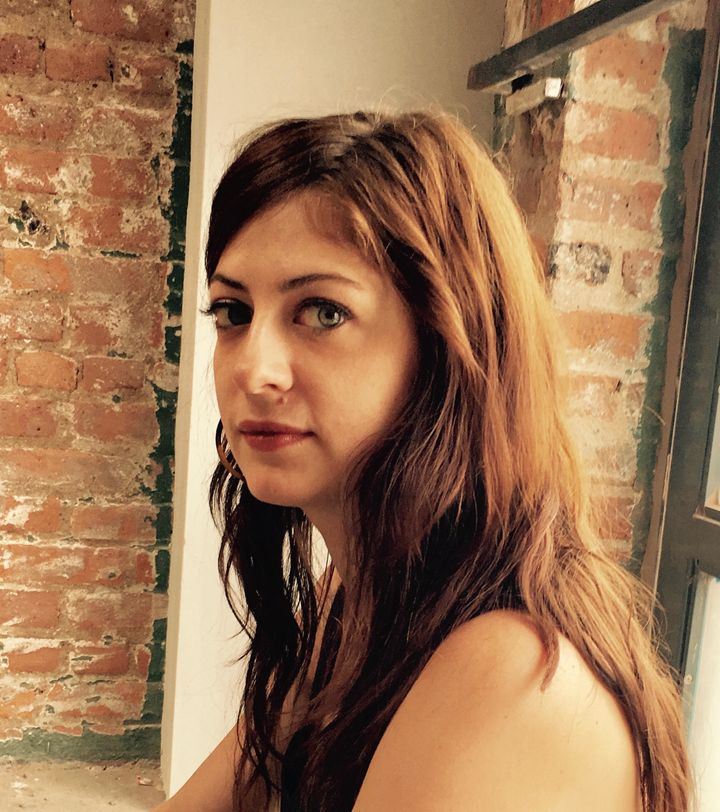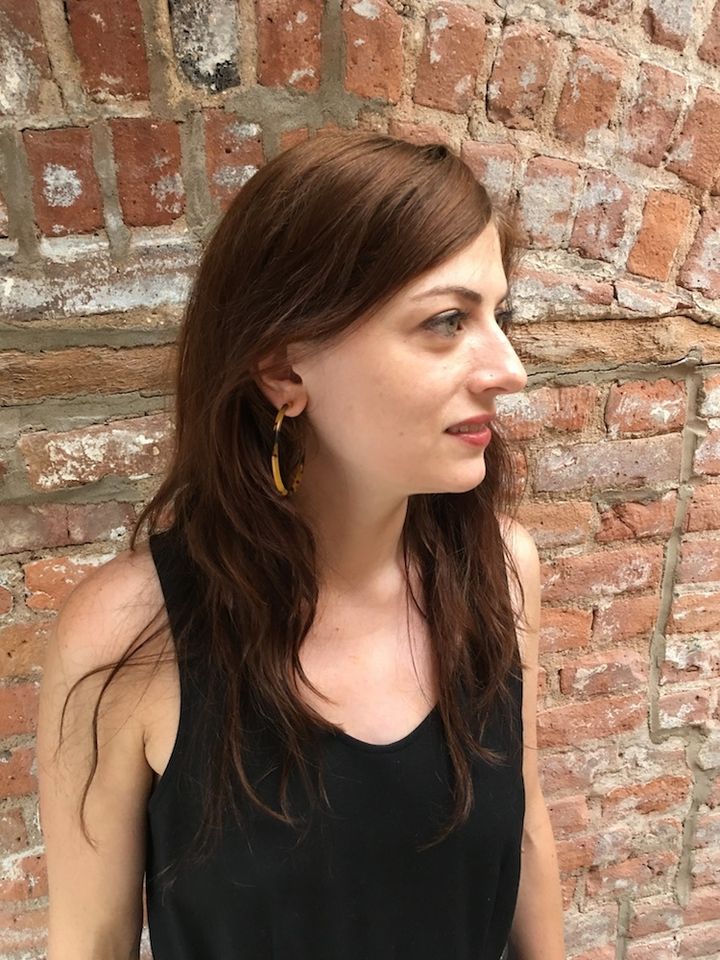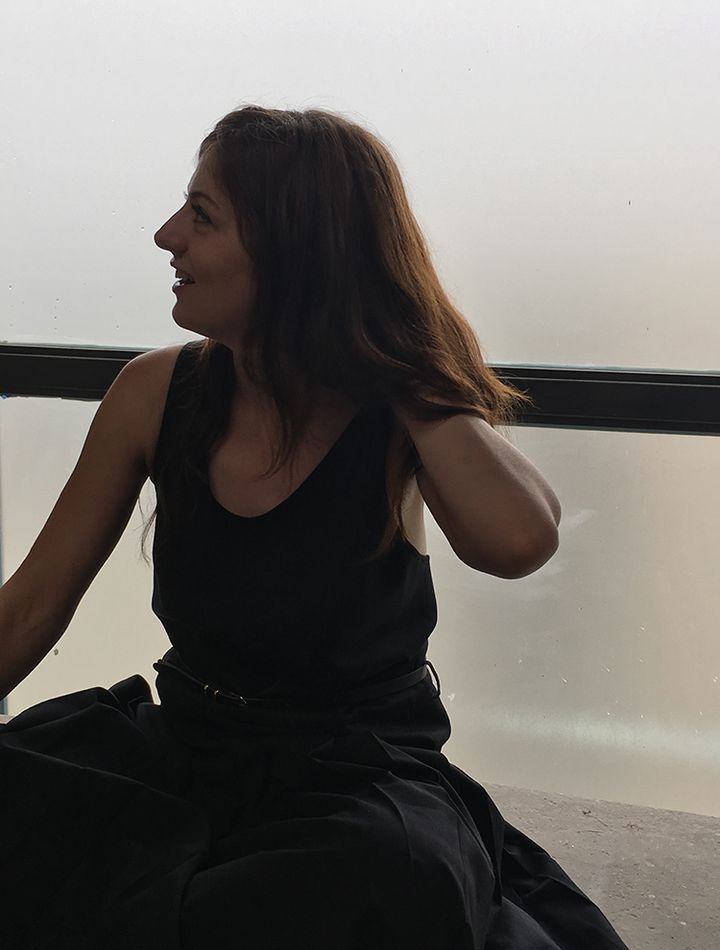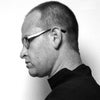Rachel Corbett is the author of You Must Change Your Life: The Story of Rainer Maria Rilke and Auguste Rodin, which won the 2016 Marfield Prize, the National Award for Arts Writing. She has also written for The New Yorker, The New York Times, The Art Newspaper, the BBC, New York Magazine, and others. At the time of this interview, she was the editor of Modern Painters magazine. She has since left the magazine and is currently working as a freelance arts writer.
This is an excerpt from a longer interview featured in the current issue of PoetsArtists magazine, Woman as Warrior.

Rachel Corbett, photographed in Brooklyn, 7/14/17
ON CAREER
Daniel Maidman: Let’s talk about you and your work and career. Did you study journalism in school?
Rachel Corbett: Yes, I went to grad school at Columbia for journalism.
DM: What did you do after that? What were the steps that led you to what you’re doing now?
RC: Honestly, I would have done about anything after grad school. I finished in 2007, and it was right about the time of the economic collapse, and magazines were laying everybody off, and it was not a good time. So I would have been a transportation reporter, or a public health reporter… anything really that I could get a job in.
I started freelancing here and there for ARTnews magazine. I had always wanted to write about art anyway. I felt like there was a big opening in arts writing, because a lot of the writers I was in school with were scared of art; they thought you had to have a PhD and that you needed to know a lot of history to write anything about art. And then a lot of the art writers I knew were not necessarily writers, they were art historians or theoreticians who were not writing the most readable stuff.
So I felt like there was a place in between that not many people were accessing. That’s what I really wanted to do. I think ARTnews was good because they’re a mix, they’re on the more journalistic side of the criticism spectrum. Since then I’ve worked at just about every art magazine. I went to artnet for a while, if you remember. They used to have a magazine online that was different from what’s online now, run by Walter Robinson. I went there, and then they closed down a year or two later and then… then what did I do? Well, I bounced around at some of these art magazines for a while, and then I went to The Art Newspaper for several years.
I decided to write the book at one point. So for four of those years, I was still freelancing but I was maybe half and half, working on the book and freelancing. I’d go in a couple weeks a month basically. When I finished the book I took stock. It was my first time back being full-time in the industry. So I’ve been editing Modern Painters for a little over a year.

Rachel Corbett, photographed in Brooklyn, 7/14/17
DM: Are there any overarching themes or structural issues that you’re interested in in your work as the editor?
RC: It varies so much. I look first and foremost for good stories. That’s what I want. Things that haven’t been told. Interesting lives. Work that engages the world, reflecting the world in some way if it’s possible. You’re always trying to find a mix between things that your readers want and things that you think they should know, people you want to introduce them to. I would say it’s more like you just know it when you see it, when you find it, than that you go out looking for it.
DM: The text from the magazine that I read didn’t feel overwhelmed with jargon, it didn’t have that exclusivity –
RC: Which one did you read, do you remember?
DM: I read the Salle interview with Dana Schutz, I read your reviews –
RC: Of course. The Salle and Schutz interview I think is really good. The reviews in the back are always a bit more varied… it’s criticism, it depends on the writer, some of them you get a bit more jargon than others; but as a whole I like it to be readable. That’s the goal. But not dumb. People who are reading an art magazine are usually pretty educated, they already know something about it if they’re picking it up in the first place. You can’t be news anymore in art magazines, you’ve got to find a way to be either analysis of a phenomenon and do a deeper look, or a feature, something that’s very nicely written that takes you into a place. You know I like that kind of thing. I like narratives, personally.
DM: Are you working on another book?
RC: Not right now. I’m thinking about it.
DM: So you have ideas percolating?
RC: Yeah, probably false starts, but I have a couple. I get torn because there are things that came out of that book, characters that were interesting that I want to revisit that sparked ideas for entire books. And then I also just don’t want to go back to Paris at the turn of the century.
THE BOOK
DM: How did you come across the story and what attracted you to it?
RC: I’ve loved Rilke since I was 19, when I read Letters to a Young Poet for the first time. My mother gave me the book. I was finishing college and trying to figure out what to do with my life, sort of teenaged depressive or just kind of unsure where to go and what to do, and I read that book cover to cover immediately in one night and then I read it again and again and again. I still read it every maybe year or so.
And then later I became an art writer and separately heard that Rilke was a secretary of Rodin’s and I thought, that’s so weird, they don’t seem at all like congruous lifetimes and figures. I looked into it a little bit, I just looked at the dates and realized that he was in Paris with Rodin when he started writing Letters to a Young Poet, and he was only 26 when he started writing that book. First I was shocked that he was so young and that he was meant to be the wise poet giving advice to a young poet, and then I thought if Rodin was his mentor… Rodin was his mentor, it turned out, for five years. Rilke went there first to write the book, then he came back to be his secretary. The third time he came back they were more equals and friends. And so during that first stay he started writing the Letters. They come from Paris.
And I thought a lot of that must be coming from Rodin. So I read his diaries from that time and his letters and compared them with Letters to a Young Poet and found traces of Rodin, and thought, what an amazing backstory to this book, that’s one of the most beloved and famous books of all time. So then I talked to my agent about it and he was like, “Yeah, great, do it.” And so it happened.

DM: Your book felt like an epic job of world-building. You had a lot of physical detail and time-specific detail. What was your process in fleshing out an abstract narrative into a highly visualized and physical phenomenon?
RC: For me what I found is that I would read the biographies, and there are many on both artists. Then I would read some of the literary criticism that put them in place and time, to just outline basically what happened when and the basic narrative structure. Then I would read books about Paris at the time to get a sense of what things smelled like there, what the streets looked like. They would be books in no way related to Rilke or Rodin. I read a book about the origins of zoos in Paris and what they meant, so I could try to imagine what the zoo looked like for Rilke or for Rodin even a couple decades later. I couldn’t even tell you what all the sources were, but a lot of historical, encyclopedic type of books, a lot about the architecture, a lot of the history of the redesigns of Paris and what that entailed. And then it was really just trying to get a picture in my head. And you try to imagine yourself on the street, looking around, and if there’s something you can’t place, if there’s an aspect like – where there trees? was there greenery around? or what was there? – you try to find a book that maybe showed pictures or stuff.
DM: I’ve noticed in books covering a historical period or an historical incident in the kind of detail that you have, some people go fully novelistic, some people give a kind of animated description of what can be obtained from primary and secondary texts, and then there’s a kind of compromise that some authors strike between what can be plausibly described, and where you have to step back and say, “And here’s what we have from documents.” I saw you doing that a few times, and I was wondering to what extent that decision was a conscious choice for the structure of the book and how it developed as you were writing the book.
RC: Do you mean like saying whether we know this or we don’t know this?
DM: Yeah. “We don’t know who the girl was.” That kind of thing. Or you’ll have a vivid description of him sitting in a room, but then you’ll back up to a quotation from a letter, and you’re not going to say, “Here’s what he was thinking.” You’re switching idioms. You know, a more novelistic and then a more historiographic depiction.
RC: Yeah, that’s a really constant battle I think, because you want it of course to read like a novel. I would love if I could. But there are moments where you just can’t make it up, you just don’t know. I spent I don’t know how many hours trying to find out who that girl was in that passage, because Rilke says it’s his [Rodin’s] daughter, but then, he never had a daughter, so that’s impossible. And I couldn’t figure it out, but I really wanted to include that scene with her. So I just thought for the sake of journalistic accuracy I just have to say, “We don’t know who it was.”
There’s a couple of other things. I think I say at one point – Rilke writes that really amazing letter after the ten days in Paris where he confesses to Rodin he’s not actually just there to write a monograph, he asks him, “How should I live?” I would have to say, “Well we don’t really know what Rodin replied.” Because we don’t have a reply. Probably he didn’t reply. You really want to know, “And then, what did he say?” But you have to back off. I’m a journalist first, by training, so I was always having to be in check. My editor was telling me to expand scenes and make them more novelistic or write more about the texture of a place or the characters. At first that was a little difficult for me, because I felt like I had to stick so much to the facts, and over time I allowed it to become more a narrative.
DM: It was very satisfying as a narrative. I mean it’s an exciting, page-turny sort of a thing. So I felt like it succeeded in that sense while clearly maintaining responsibility as a piece of research.
RC: Well, the good thing is that there’s a lot of material on these guys. They’re so hugely famous that I couldn’t even begin to read all of the books on them. There’s a lot of material to work with, you just have to shape it. There was much less on Rodin’s inner life. We don’t know it as well, because he didn’t keep letters or diaries the way Rilke did. But that also works in the story because he becomes this cold, stoic, more exterior figure.
DM: I’ve always gotten a sense of him as an almost totally exteriorized person.
RC: Yeah. And he was a master of surfaces, so he kind of believed everything should live on the surface, everything you need to know about a sculpture you can see, the emotional expression should all come through… and that may be how he lived, a little bit. He didn’t say much, he felt like you could get everything you need to know just by watching him work. He did like to talk and he did interviews, but he only talked about his work.
DM: Your description of him is of a person almost completely unaware of their surroundings. Is that the impression you got from what people write about him?
RC: Yeah. Literally when he was working sometimes, that’s what people would say, they would be talking over here, and he would be looking at a nose or something and tinkering with it and just stop hearing them speak and tune them out. Or he would have models come in and then he would forget about them and they would just be sitting there for hours waiting and he would work all night long and never address them. He did have that aspect it seems. A workaholic, obsessive in his work. And he didn’t really care about anything else, it seems to me. Other than women who were not his wife, he didn’t really care.
DM: You know the early sculpture of her [Rodin’s wife Rose Beuret] and then the later sculpture of her, right? Like there’s one of her as an adorable peasant girl, and then the next sculpture you see she’s middle-aged. It was kind of shocking how unaffectionate the later one was.
R: Well he has this kind of funny saying, when he first met her he’s like, “I loved how strong and vigorous and hardy she looked,” almost like he gave her masculine attributes. That’s what he liked about her though, she looked like a peasant, like a hard-working peasant woman, and he’s like, “I was attracted to that immediately.” So it’s a weird thing where it seems unflattering, and yet that’s what he was drawn to. And he was kind of that way himself. He wasn’t quite a peasant, but he was a middle-class guy who believed strictly in labor and work and that was it. So they were kind of a good match in that way, she embodied those qualities for him.
DM: All I know is about her is him humiliating her with Camille Claudel.
RC: Yeah, he was not a good partner, that’s for sure. I mean, she endured a lot. Rilke has a beautiful description of her. He says that she was like a teacup held beneath a waterfall. That’s how she handled Rodin.
DM: That’s fantastic.
RC: Isn’t that great? That was what her life was, with Rodin. She was like his maid basically. First she was his studio assistant, then she modeled for him. She covered up the clay with wet cloths at night, she tended to all of that, and then also tended to the house, cooked and cleaned.
DM: Did she have suds on her arms that one time? Does Rilke mention it?
RC: Yeah! It’s in there. I think it’s a description Rilke writes. He writes about her, he doesn’t know who she is at first, and she’s got an apron and soap suds on her hands like a maid.
WOMEN IN THE WORLD OF RODIN AND RILKE
DM: So let’s talk about the role of women in the lives of the characters.
RC: One of the most common comments I get about the book is that it has such great women characters and that it’s a feminist book, which is not anything that I set out to do writing a book about two dead white men, but I’m of course thrilled by that assessment. It just treats Clara Westhoff, who’s Rilke’s wife, as a real character and artist, which she was, and their mutual friend Paula Modersohn-Becker, who was a brilliant painter, probably the most talented among that young group at the time, and she was a big figure in Rilke’s life also – and then also Camille Claudel and Rose Beuret, the wife of Rodin… it just basically treats them all as people. I don’t know why people keep talking about the women in the book, but I think it’s because Rilke and Rodin didn’t surround themselves with uninteresting women, they were drawn to accomplished, talented women, so they are interesting figures on their own.

Rachel Corbett, photographed in Brooklyn, 7/14/17
For more on women and their work and role in the world of Corbett’s book, and for Corbett’s thoughts on contemporary figurative art, see the rest of this interview in PoetsArtists Woman as Warrior.
You Must Change Your Life: The Story of Rainer Maria Rilke and Auguste Rodin is available from Amazon.
